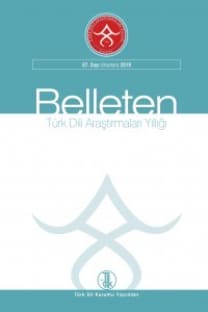UYBAT VI (E98) YAZITINDA GEÇEN AZIGLIG KELİMESİ ÜZERİNE BİR ANLAMLANDIRMA DENEMESİ
Azıglıg, Azılı, Uybat VI yazıtı, Köl İç Çor yazıtı
UYBAT VI (E98) YAZITINDA GEÇEN AZIGLIG KELİMESİ ÜZERİNE BİR ANLAMLANDIRMA DENEMESİ
___
- Aksan, Doğan (2000): En Eski Türkçenin İzlerinde, Orhun ve Yenisey Yazıtları ÜzerindeSözcükbilim, Anlambilim ve Biçembilim İncelemelerinin Aydınlattığı Gerçekler. İstanbul: Simurg.
- Arat, R. Rahmeti (1979): Kutadgu Bilig, III İndeks. Hzl. Kemal Eraslan-Osman F. Sertkaya-Nuri Yüce. İstanbul: TKAE.
- Ata, Aysu (1997): Kısasü’l-Enbiyā (Peygamber Kıssaları) II Dizin, Ankara: TDK.
- Barutçu-Özönder, F. Sema (1998): Üç İtigsizler. Ankara: TDK.
- Berta, Árpád (2004): Szavaimat Jḥl Halljátok, A Türk ʾs Ujgur Rovásírásos EmlʾkekKritikai Kiadása. Szeged: Jate.
- Borovkov, A. K. (2002): Orta Asya’da Bulunmuş Kur’an Tefsirinin Söz Varlığı (XII.-XIII.Yüzyıllar). Çev.: Halil İbrahim Usta-Ebulfez Amanoğlu, Ankara: TDK.
- Caferoğlu, Ahmet (19933): Eski Uygur Türkçesi Sözlüğü. İstanbul: Enderun.
- Clauson, S. Gerard - Edward Tryjarskı (1971): The Inscription at Ikhe-Khushotu. RocznikOrientalistyczny 34/1, 7-33.
- Clauson, S. Gerard (1972): An etymological dictionary of pre-thirteenth-century Turkish.Oxford: Oxford University.
- Derleme Sözlüğü. 2. bs. Ankara, 1993: TDK.
- ISSN: 0564-5050
- Yayın Aralığı: 2
- Başlangıç: 1953
- Yayıncı: Türk Dil Kurumu
DÖNÜŞLÜLÜK ZAMİRİ ÖZNE OLABİLİR Mİ?
UYBAT VI (E98) YAZITINDA GEÇEN AZIGLIG KELİMESİ ÜZERİNE BİR ANLAMLANDIRMA DENEMESİ
MUHTASAR SARF-I OSMÂNÎ ALİ NAZİMA
BAŞKURTÇA SÖZ VARLIĞI ÜZERİNE NOTLAR
VURUŞ KAVRAMLI TÜRKÇE AKRABA KELİMELER: SES OLAYLARI VE ETİMOLOJİ
DOĞUMUNUN 100. YIL DÖNÜMÜ DOLAYISIYLA PROF. DR. SAADET ÇAĞATAY
